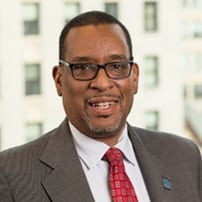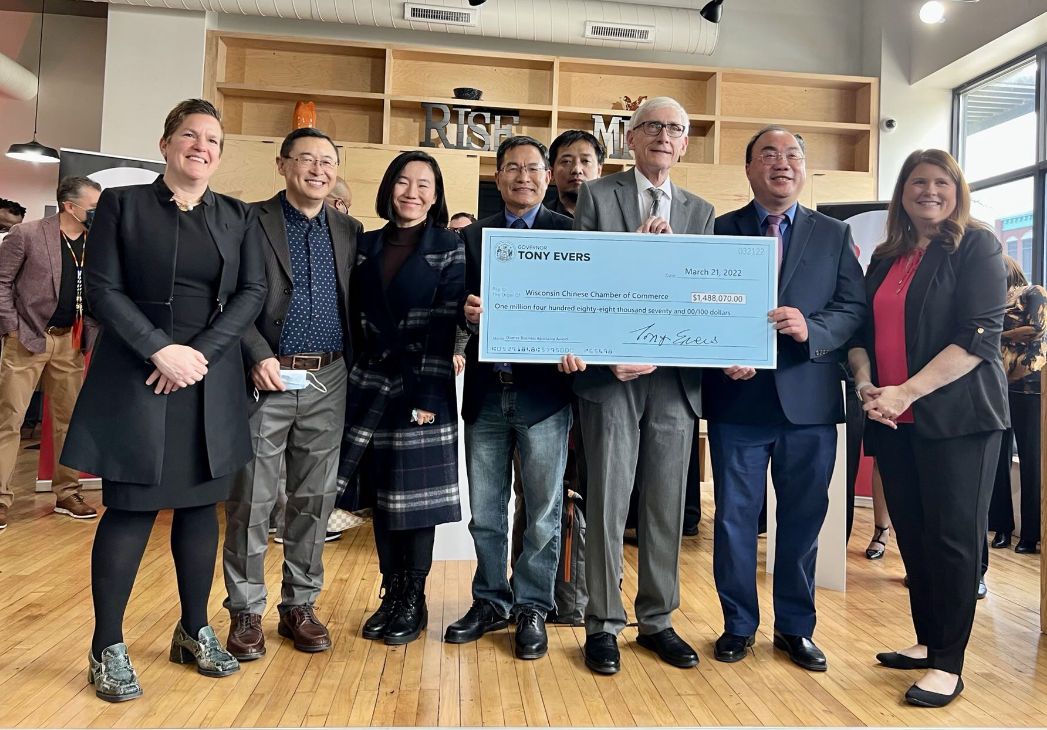
Quad personnel with staff and students from the Warrior Innovation Center (the Waupun Area School District’s fab lab). Quad is one of the fab lab’s sponsors and supporters.

Students apply a custom car wrap for Tony’s Pizza, another local business that supports the Warrior Innovation Center in Waupun. The fab lab students designed and printed the car wrap, and this project has since led to other opportunities to complete projects for local businesses.
When a school constructs a fabrication laboratory (fab lab), the primary goal is to equip students with hands-on experience in science, technology, engineering, arts and mathematics (STEAM) fields. But the impact of such a lab goes far beyond the classroom, and the most successful fab labs are those that have strong corporate partnerships and relationships with the local community.
“If they are going to make the maximum possible impact, fab labs in Wisconsin schools must be integrated with their communities and area employers,” says Vincent Rice, WEDC senior director, sector strategy development. “That’s why WEDC has built community engagement and corporate partnerships into the evaluation criteria for its Fab Labs Grant Program.”
In the spring of 2019, WEDC awarded 20 grants totaling $520,399 to school districts throughout Wisconsin to establish or expand their local fab lab facilities. The grant program has invested over $2.1 million in Wisconsin school districts’ fab labs over the last four years.
Teaching innovation and creativity
Waunakee recently completed a three-year grant cycle, the maximum number of grants allowed for one district through this program. The first grant year covered construction and renovation of the lab space. In the second year, the district undertook creation and implementation of the curriculum for courses to be offered in the new space, as well as training and professional development for staff members and targeted outreach to certain student populations. The district used the third grant year to develop additional course offerings and implement its plans to open the space for community events and classes. It has also implemented technology to collaborate remotely with fab labs in other locations (including other school districts elsewhere in Wisconsin, the U.S. and worldwide) via videoconference.
“The projects our students are creating are, quite simply, mind-blowing,” says Michelle McGlynn, school-to-career coordinator for Waunakee Community School District. “We’ve had students create a complete video game console. One student built a skateboard, another a ukulele. Far beyond the technical skills involved, students are learning how to be innovative and creative. They are learning how to solve problems that may not have a defined solution, and they are developing critical thinking skills that will benefit them far into the future.”

Fourth-grade students learn how to weed heat press material on a T-shirt at the Warrior Innovation Center in Waupun.
Partnerships with local businesses have been key in the development of the Warrior Innovation Center, as the fab lab in Waupun is called. Currently in its second grant year, the Waupun Area School District has used grant funds to expand both its fab lab’s physical size and the lab’s integration with multiple curriculum areas. Classes that have used the lab include not only jewelry-making, woodworking and ceramics, but science, business entrepreneurship and Senior Democratic Seminar.
The fab lab has active partnerships with Mayville Engineering Company in Beaver Dam—which has hosted tours for students and has guided the education of students in powder coating and fabrication—and Quad in Lomira—which donated money for the purchase of a large format printer for the fab lab and is a regular and active participant in the school’s youth apprenticeship program.
Multiple community groups have held meetings in the space or visited for tours, and the district has plans to offer a broad array of courses that would be open to the community. “Once we’ve established this positive relationship, we would like the community to utilize the equipment for their own innovative ideas,” says Dawn Disch, the district’s fab lab director.
Even before they became fixtures in schools, fab labs were envisioned as spaces for communities, says Mike Connor, cofounder of the fab lab at Stoughton High School, which was the first high school in Wisconsin and the second in the nation to have a fab lab when it opened in 2013. The fab lab has received two WEDC grants and has a robust list of roughly one dozen community and corporate partners. “Originally designed for communities as prototyping platforms for local entrepreneurship, fab labs are increasingly being adopted by schools as platforms for project-based, hands-on STEAM education,” says Connor.
Now, Stoughton’s fab lab is coming full circle with the Opportunity Hub (OPHUB) project, a multimillion-dollar investment to improve the technical literacy of the surrounding community. Funded so far by Stoughton Area School District and the Wahlin Foundation, with other potential supporters expressing interest, the project includes workforce development initiatives and plans for a STEAM-focused school and a startup incubator.
Solving real-world problems
Mount Horeb was one of the new school districts to receive a Fab Labs Grant for the first time in 2019. The construction of a fab lab as part of a new STEAM wing was recommended in 2016 as part of the school district’s facilities study. The new wing and fab lab will be ready for use in the upcoming school year, and staff will be trained on the new equipment when they return to work in August.
Mount Horeb Area School District Director of Instruction Sarah Straka notes that the fab lab is specifically being designed with the community in mind, including external entrances for public access, along with a glass wall and large windows that afford visibility into the lab. The school district plans to work with the local recreation department to offer community workshops, and one student organization has already begun planning “family nights” to introduce students’ families to the fab lab and its capabilities. “These family nights will be offered in collaboration with our high school student organizations to invite our youngest learners and the adults in their lives into our amazing space,” says Straka. “We are also working to develop partnerships with Madison College to offer this space as a satellite location for adult learning.”
Through a partnership with the Mount Horeb Area Economic Development Corporation, the district will keep in touch with the needs of the local business community so it can better target fab lab offerings to give students the skills local employers are seeking. One early supporter has been Midwest Prototyping, a 3D printing provider that hosted a youth apprenticeship student and has helped guide the development of the fab lab.
Merrill Area Public School District, another district in its first grant year, began involving the community even prior to the fab lab’s construction. In fact, the very idea for the fab lab came from community conversations that led to a local referendum where funding to construct the lab was approved.
The grant will be used to purchase additional equipment including a CNC plasma table, a CNC mill, a CNC lathe and a 3D scanning tool. Joshua Zalewski, the district’s fab lab director, says that with the new equipment he is focusing on the needs of the local metalworking industry, after interviews with local employers indicated a shortage of applicants with the right skills for the companies’ open jobs.
The Merrill fab lab students have already met a need for one local company. They have created a hinge for the lasts—foot-shaped forms—that are used in the shaping of boots made by Weinbrenner Shoe Company, one of the fab lab’s supporters and community partners. Having trouble finding replacements for broken hinges, company President Patrick Miner asked if the fab lab students could help. The students were able to use computer-assisted design and a 3D printer to create an acrylic replica of a hinge. “Once we get our CNC plasma table, we’ll be able to make the 300 or 400 of these the company needs,” says Zalewski.
Fab labs create a pipeline of talent for employers—but as it turns out, fab labs need their own pipeline of students being introduced to STEAM skills at a young age to develop the interests and abilities that will allow them to take full advantage of the fab lab when they get to high school. On that note, Zalewski also sought and was awarded a grant from a local foundation to offer an introductory STEAM workshop to fifth-graders. The students visited the fab lab and were assigned to draw an object, which a high school student then cut into a mosaic tile using the CNC router; the tiles were assembled into a mosaic, which several local businesses took turns displaying. “It was just fantastic to see these kids take the idea in their head, put it down on paper, and then see the machine bring the design to life,” says Zalewski.
“When they are fully integrated into their communities,” says Rice of WEDC, “fab labs not only benefit the high school students who use them every day—they benefit nearby employers, the entire K-12 education system, and community members who can use the equipment to learn new skills or complete a project. We commend these Fab Labs Grant recipients for their creative thinking and leadership in helping these facilities have a broad ripple effect.”







